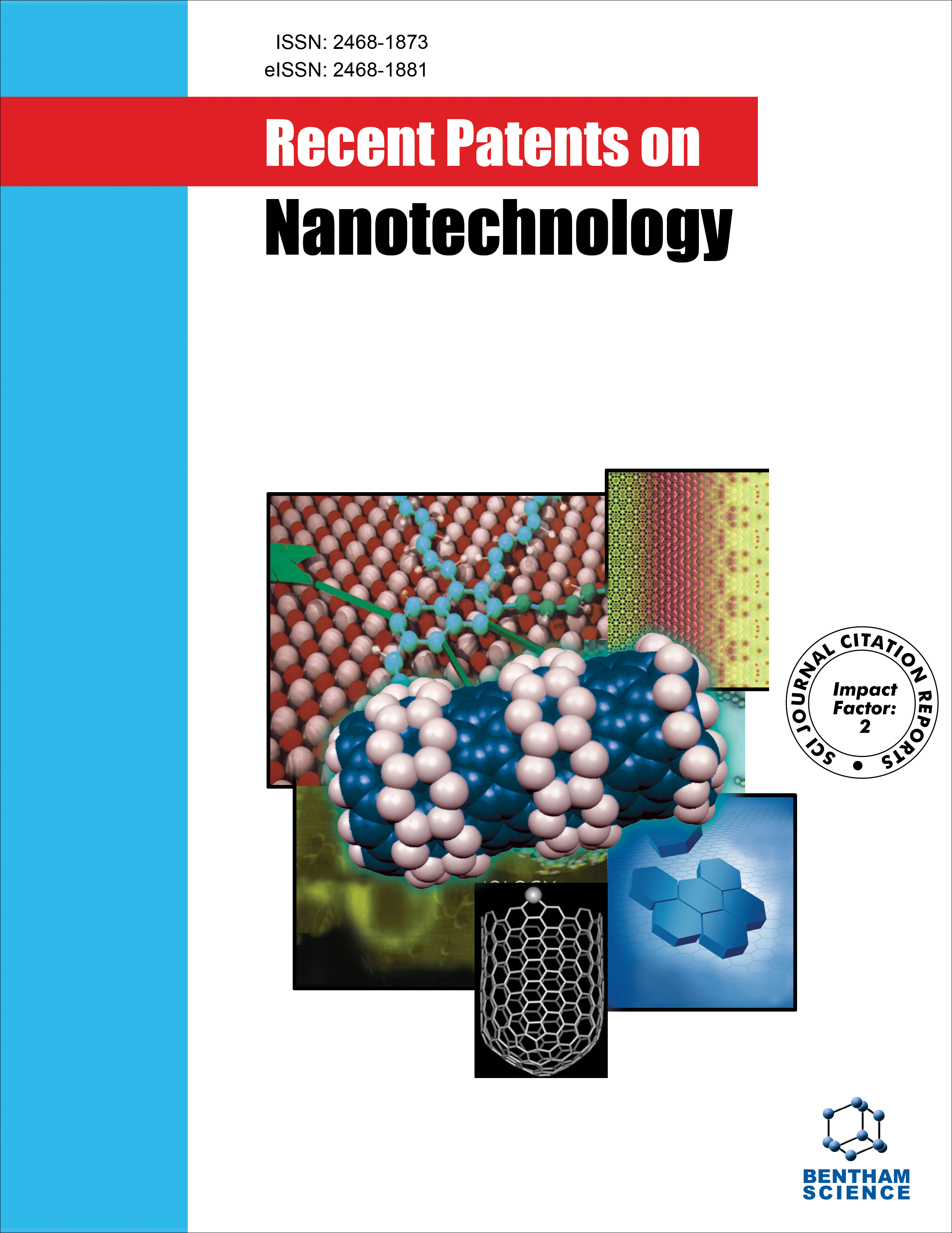- Home
- A-Z Publications
- Recent Patents on Nanotechnology
- Previous Issues
- Volume 17, Issue 3, 2023
Recent Patents on Nanotechnology - Volume 17, Issue 3, 2023
Volume 17, Issue 3, 2023
-
-
Passive Solar-driven Interfacial Evaporation Nanosystems: Beyond Desalination Towards Multiple Applications
More LessAuthors: Minhao Sheng, Xiaoqing Bin, Yawei Yang and Wenxiu QueRecently, passive solar-driven interfacial evaporation has become one of the fastest-growing technologies for solar energy utilization and desalination. Herein this patent, we provide an overview of other emerging and potential applications of evaporation nanosystems beyond desalination, i.e., electricity generation, organics rejection, and sterilization. These extended functions can be a benefit for energy and e Read More
-
-
-
A Discursive Review of Recent Development and Patents on Glycerosomes
More LessAuthors: Ragini Singh, Fatima Zeeshan, Dipti Srivastava and Himani AwasthiBackground: To achieve a target-based drug delivery with minimal side effects, novel drug delivery systems are being continuously explored. Vesicular systems are one such system that can ameliorate the bioavailability of the encapsulated drug by delivering the drug at the targeted site and can minimize the side effect. Objective: The objective of this patent review is to provide a vivid description of glycerosomes and thei Read More
-
-
-
Nanocapsules: An Emerging Drug Delivery System
More LessBackground: Controlled drug release and site-specific delivery of drugs make nanocapsules the most approbative drug delivery system for various kinds of drugs, bioactive, protein, and peptide compounds. Nanocapsules (NCs) are spherical shape microscopic shells consisting of a core (solid or liquid) in which the drug is positioned in a cavity enclosed by a distinctive polymeric membrane. Objectives: The main objective of the pr Read More
-
-
-
Progresses in Nano-Enabled Platforms for the Treatment of Vaginal Disorders
More LessAuthors: Riya Patel, Bindu K. Yadav and Gayatri PatelBackground: The most common vaginal disorders are within the uterus. According to the latest statistics, vaginal disorders occur in 50% to 60% of females. Although curative treatments rely on surgical therapy, still first-line treatment is a non invasive drug. Conventional therapies are available in the oral and parenteral route, leading to nonspecific targeting, which can cause dose-related side effects. Vaginal disorders are localiz Read More
-
-
-
Solid Lipid Nanoparticles: Peculiar Strategy to Deliver Bio-Proactive Molecules
More LessAuthors: Neha Minocha, Nidhi Sharma, Ravinder Verma, Deepak Kaushik and Parijat PandeyBackground: Novel Drug Delivery Systems (NDDS) provide numerous benefits compared to conventional dosage forms. Poor aqueous solubility, low bioavailability, frequent dosing, and particular hydrophilic lipophilic character of the drug are the biological factors associated with the traditional systems leading to the development of SLNs. Objective: For improving the solubility profile, enhancing the bioavailability, and attaining t Read More
-
-
-
Tomato as a Natural Source of Dyes in the Food Industry: A Patent Data Analysis
More LessBackground: Foods that promote health benefits are being increasingly used. Innovative techniques, such as nanotechnology, have been used to improve functional properties, sensory characteristics, or the conservation of foods. Objective: The objective of this study was to identify the technological domain of patents for tomato products with or without nanotechnology and elucidate the technological advances associat Read More
-
-
-
Formulation Optimization and Evaluation of Nanocochleate Gel of Famciclovir for the Treatment of Herpes Zoster
More LessAuthors: Abhishek Kanugo, Ashwini Deshpande and Rahul SharmaBackground: Herpes zoster is a viral infection triggered due to the reactivation of the varicella- zoster virus in the posterior dorsal root ganglion. Herpes zoster infections occur mostly in the facial, cervical and thoracic regions of the body, beginning with pain and resulting in the vesicular eruption. Recently, this infection was observed during the COVID-19 pandemic and also after the induction of mRNA-based vaccine for c Read More
-
-
-
Green Synthesis of Silver Nanoparticles of Vernonia cinerea Leaf Extract and their In vitro Cytotoxicity Activity against Neuroblastoma SHSY-5Y Cell Lines, Antimicrobial and Antioxidant Studies
More LessBackground: Green syntheses of silver nanoparticles using plant extracts have potential anti- cancer, antimicrobial, and antioxidant properties, among other aspects. The aim of the present patent study was to synthesize silver nanoparticles (AgNPs) using Vernonia cinerea plant extract. Methods: The AgNPs were successfully prepared and characterized using UV-Vis Spectrophotometer, particle size, Zeta potential, Trans Read More
-
Volumes & issues
-
Volume 19 (2025)
-
Volume 18 (2024)
-
Volume 17 (2023)
-
Volume 16 (2022)
-
Volume 15 (2021)
-
Volume 14 (2020)
-
Volume 13 (2019)
-
Volume 12 (2018)
-
Volume 11 (2017)
-
Volume 10 (2016)
-
Volume 9 (2015)
-
Volume 8 (2014)
-
Volume 7 (2013)
-
Volume 6 (2012)
-
Volume 5 (2011)
-
Volume 4 (2010)
-
Volume 3 (2009)
-
Volume 2 (2008)
-
Volume 1 (2007)
Most Read This Month
Article
content/journals/nanotec
Journal
10
5
false
en


